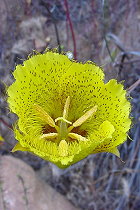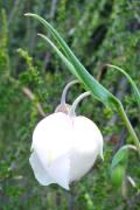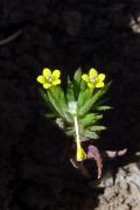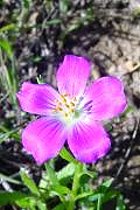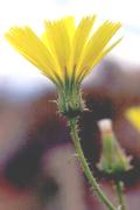- quadrangular'is: four-angled, from Medieval Latin quadrangularis, "having four corners."
- quadrangula'ta: same as quadrangularis.
- quadricosta'ta: four-ribbed.
- quadrifo'lia: four-leaved or -needled.
- quadriperfora'ta: with four perforations.
- quadripet'alum: with four petals.
- quadriradia'ta: with four ray florets or with four radiating structures.
- quadrival'vis: with four valves.
- quadrivul'nera: the root vulner comes from Latin vulnerator, one who wounds or mutilates, in
turn from vulnus, a wound, or vulnero, to injure, damage,
so this means something like "with four wounds or injuries."
The Clarkia which bears this name has 4 petals, each of which
has a darker pinkish-purple spot on it, as if it were wounded and
bleeding.
- qua'mash: according to Wikipedia, "The name Quamash is a native
American term for the plant's bulb, which was gathered and used as
a food source by tribes in the Pacific Northwest. The bulbs were harvested
and pit-roasted or boiled by women of the Nez Perce, Cree, and Blackfoot
tribes. It also provided a valuable food source for the members of
the Lewis and Clark expedition (1804-1806)."
- quartinia'num: named for Léon Richard Quartin-Dillon (1811/4-1840), a physician, botanist and museum naturalist. He was born Ricardo Leão Quartin in Lisbon the son of a father from Gibraltar and a Portuguese mother. His second surname may have come from the Irish-French husband of one of his aunts. He embarked on a voyage from 1838 to 1843 led by Théophile Lefebre to study the natural history, geography, anthropology, linguistics, archeology and customs of Abyssinia. Material that he and others on the expedition collected formed the basis for Achille Richard's two-volume flora of Ethiopia entitled Tentamen Florae Abyssinicae. Quartin-Dillon during the expedition and A. Petit took over the botanical collecting until his death in 1843.
- quercetor'um: of oak woods.
- quercifo'lium: with leaves like those of genus Quercus.
- quercin'us: relating to oaks.
- Quer'cus: the classical Latin name for the
English oak, Quercus robur, from Roman times. Interestingly no certain derivation for the name exists, possibly it derives from the Celtic quer, "fine,"
and cuez, "tree."
John Cameron's Gaelic names of plants (Scottish and Irish) (1883)
states:
"Quercus — Said in botanical works to be from the Celtic, quer, fine. There is no such word in any Celtic dialect, and even [Arnold] Pictet has failed, after expending two pages on it, to explain it."
Another source (Gledhill) says that it shares the same linguistic derivation as the Arabic al-qurk and the word cork. Also it has been suggested that it comes from the Proto-Indo-European word kwerkwu which in turn is derived from perkwu, "oak. "The genus Quercus was published in 1753 by Carl Linnaeus.
- quibel'lii: named for Charles Hicks (‘Chuck’) Quibell (1902-1995), an American botanist and plant collector. He was born in California and died in Fresno. His ashes were scattered in the High Sierras.
- quick'ii: named for Clarence Roy Quick (1902-1987), a plant ecologist who
worked for the U.S. Department of Agriculture. He was a forest ecologist
for the US Forest Service and a plant pathologist and consultant
for the Pacific Southwest Forest and Range Experimental Station. Some
of his areas of research included seed germination, dormancy and longevity,
ecology of forests and forest species, and chemical control of plants
and tree diseases. He wrote articles on gooseberries, blister rust,
fungicides and germination of Ceanothus seeds.
- quinquiflor'a: with five flowers.
- quiten'sis: of or from Quito, Ecuador.
|
